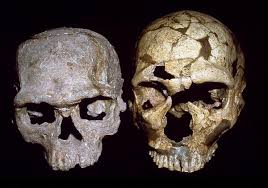Jun 12 2017
Earliest Modern Human
 Last month I wrote about Graecopithecus, a possible human ancestor from just after the split with chimpanzees about 7 million years ago. Also last month it was reported that an analysis of new Homo naledi specimens dates the fossils from as recently as 236 thousand years ago. H. naledi share some primitive features that paleontologists thought would date to about 2 million years old, but they also have some more modern features.
Last month I wrote about Graecopithecus, a possible human ancestor from just after the split with chimpanzees about 7 million years ago. Also last month it was reported that an analysis of new Homo naledi specimens dates the fossils from as recently as 236 thousand years ago. H. naledi share some primitive features that paleontologists thought would date to about 2 million years old, but they also have some more modern features.
In April I also wrote about the latest study of H. floresiensis (the Hobbit) showing that it is very likely this was indeed its own species.
All of these news items share a theme – that the picture of the evolution of modern humans from our last common ancestor with chimpanzees is likely much more complicated than we currently know and previously suspected. I think the analogy of a jigsaw puzzle is apt. We are trying to piece together this puzzle, but we don’t know what the final picture looks like. We are connecting lines to the pieces we have, but when we find more evidence we are not just filling in the picture, we are expanding it.
Our map of how human evolution proceeded was just a best fit to the existence evidence. We are still in a stage of our discovery where every new major find alters that best fit. This process was inevitable as we started with a maximally simple (and naive) map – a linear progression from apes to humans. Now we know, as with pretty much every other evolutionary tree, the real map is much more bushy. Adaptive radiation lead in multiple directions simultaneously, only one branch of which survived to be modern humans.
Homo Sapiens from Jebel Irhoud
Here is the latest curve ball in this emerging picture. There is a well-preserved hominid site from Jebel Irhoud in Morocco. Previously paleontologists found a nearly intact skull, mandible, and some post-cranial fossils from a site with numerous other animals, stone tools, and evidence of fire use. The skull looks very modern. It was first thought to be perhaps Neanderthal, but later analysis leans toward modern H. sapiens.
We were not able to accurately date the fossils, however – that is, until recently. Additional fossils were found in situ at the site, which has enabled direct dating. As reported in Nature, the current date of these fossils is 315 ± 34 thousand years ago. That is much older than previously thought, especially considering how modern the skulls are.
A details analysis of the fossils shows that they fit well into the morphological features of archaic humans. These are the first H. sapiens specimens, but with some subtle features that mark the earliest specimens and eventually disappear.
The two details of this new find which are most interesting are the location and age. Morocco is African, but it is northern African. Most fossil specimens of hominids in Africa are sub saharan. These specimens are also at least 100,000 years older than the previously oldest specimens from Ethiopia.
So how does this change our “best fit to the evidence?” Of course, it’s still not clear, but the implications can be huge. Prof Jean-Jacques Hublin, of the Max Planck Institute (MPI) for Evolutionary Anthropology in Leipzig, Germany, whose team made the discovery believes that this evidence supports not only an earlier emergence of modern humans in Africa, but that this emergence was much more widespread.
It is possible that populations of early H. sapiens were spread throughout Africa. In support of this are several sites dating to about 300,000 years ago that contain similar stone tools and evidence of fire use, but no hominid fossils with which to connect them. It was assumed that an older species was responsible for these sites, but perhaps it was H. sapiens.
I think part of the challenge in trying to wrap our heads around the picture of human evolution is that the very concept of “species” is fuzzy. If we try to understand an evolutionary tree at this fine scale, the species concept breaks down. We have to think more in terms of populations, which are fluid and interbreeding. A “species” is more of a meta-stable collection of features.
Clearly hominids were spread throughout Africa at this time, representing various branches that were likely, at least occasionally, interbreeding. What we now recognize as Homo sapiens was simply a dominant collection of features that was likely widespread by at least 300,000 years ago and maybe earlier. Representatives of this group migrated out of Africa where they further evolved, competed with and interbred with the local Neanderthals, and branched off themselves into subpopulations.
Further, layered on top of this is culture. This is an element we don’t have with non-human species, but humans are inventive and make artifacts that can survive millions of years, like stone tools. So, we can also track the evolution of human culture through the tools they left behind, as well as evidence for fire use and other cultural practices (like burying their dead).
The whole picture of human evolution is a fascinating story that is only getting more interesting.






